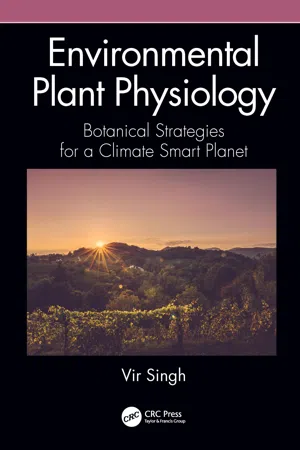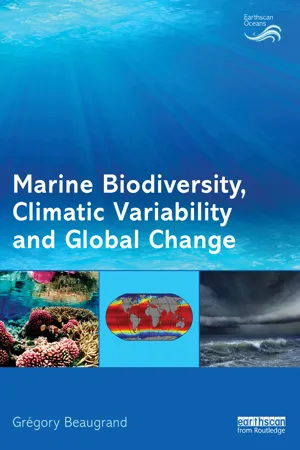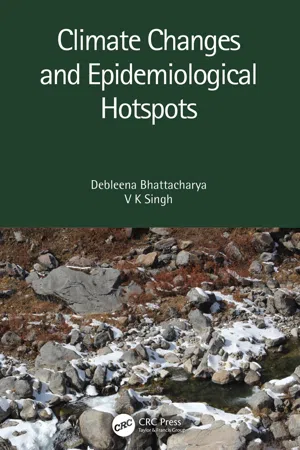Effect of Climate Change
The effect of climate change refers to the various impacts of global warming and shifts in weather patterns on the environment, ecosystems, and species. These effects can include changes in temperature, precipitation, and sea levels, leading to shifts in habitats, altered migration patterns, and disruptions to ecological relationships. Overall, climate change poses significant challenges to the stability and functioning of biological systems.
6 Key excerpts on "Effect of Climate Change"
- eBook - ePub
Environmental Plant Physiology
Botanical Strategies for a Climate Smart Planet
- Vir Singh(Author)
- 2020(Publication Date)
- CRC Press(Publisher)
...inundation of habitats near oceans and seas; • Adverse effects on Earth’s ecosystems: changes in the structure, composition, and functioning, alteration in biogeochemical cycles, changes in energy flows, decrease in productivity; • Adverse effects on the physiology and performance of organisms; • Spurt in pathogens and pathogenesis: climate-related diseases; • Acceleration in species’ extinction rate. IMPACT OF CLIMATE CHANGE ON PLANT PHYSIOLOGY Specialized species and communities prosper within a range of temperatures—that varies over short periods of time (weather) and according to the atmosphere’s “behavior” over relatively long periods of time (season). And this becomes the basis for survival, functioning, and sustenance of the species and ecosystems. A range of the temperatures over weather and season—or climate of a geographical region—phenomenally influences life: structure and functioning of communities, which, in turn, are influenced by physiological processes. Deviation in the normal range of temperature, be it in the lower side or in the higher side, induces stress among organisms. The precipitation regime is gradually becoming a “victim” of the changing temperature regime. The precipitation regime sets up conditions for an evolutionary ecosystem structure, appropriate ecosystem functioning, and a level of primary productivity. Global warming phenomenally activates the hydrological cycle due to which a shift in the precipitation regime can be readily expected, which will create greater “dry versus wet conditions” extremes (Medvigy and Beaulieu 2012). Such a shift is bound to influence soil–water–plant relations and interactions between plants and other organisms. Plant physiological traits, as a result, are readily affected by the changing mode of interactions between plants and other organisms arising out of elevated atmospheric temperatures and subsequent hydrological behavior...
- Grégory Beaugrand(Author)
- 2014(Publication Date)
- Routledge(Publisher)
...Part 3 Theorising and scenarising biodiversity Chapter 11 Theorising and scenarising biodiversity 11.1 Introduction As we saw in Chapter 7, global climate is expected to change at a magnitude rarely reached in recent history, threatening the organisation and the distribution of ecosystems and their biodiversity. Ecologists and bioclimatologists are urged to understand and anticipate both biological and ecological changes because they may have strong consequences for supporting, provisioning and regulating services (Chapters 7 and 10). How will species redistribute and what are the likely effects for ecosystem properties? How will diversity and other functional attributes change? What will be the consequences for ecosystem functioning, services and biogeochemical cycles? What will be the new ecosystems of some currently productive seas? These questions have lately gained enormous importance, especially since climate-induced changes in ecosystems have already been observed (Chapter 7). During a first phase, a phase I believe not yet fully completed, investigations on the effects of climate change on marine species and ecosystems have focused on single patterns (e.g. phenological or biogeographical shifts), single functional attributes (e.g. diversity, size) or ecoregions. As we saw in Chapters 5 and 7, the principal research aim was to determine whether global climate change may affect biological and ecological systems and whether the effect of warming was already perceptible in natural systems (427, 663). This remains a difficult task because climatic variability (Chapters 1 - 5) is hard to disentangle from anthropogenic climate change (Chapters 5 and 7), ocean acidification (Chapter 8) and sometimes more direct anthropogenic effects such as fishing (Chapter 9)...
- eBook - ePub
Biogeography
An Integrative Approach of the Evolution of Living
- Eric Guilbert(Author)
- 2021(Publication Date)
- Wiley-ISTE(Publisher)
...2016; Diele-Viegas et al. 2019). Some ectotherm species exhibit temperature-dependent sex determination, where the environmental temperature experienced during the embryonic/larval development determines the sex of the offspring (Bull 1980). Others might experience stressful environments affecting their population dynamics, leading to a population collapse within a few generations if no acclimatization or local adaptation is possible (Diele-Viegas et al. 2019). Shifts in phenology of plants and animals have already occurred over recent decades, one of the most documented population being aspects influenced by the climate changes. The earlier occurrence of spring events, such as breeding, emergence from hibernation, onset of flowering and migration, has been observed in hundreds of species in many regions (e.g. Primack et al. 2009; Cook et al. 2012; Peñuelas et al. 2013). Thus, the disruption of ecological interactions, such as herbivory, predation, pollination networks and abundance of pest species, is also likely to occur (Tylianakis et al. 2008; Schweiger et al. 2012). Primary productivity, timber and pulp production are sensitive to most aspects of climate change, being indirectly affected by the effects of climate on pests and diseases (Seddon et al. 2016). Notably, evapotranspiration can be affected by multiple factors of climate change, such as temperature, drought, solar and thermal radiation (Luo et al. 2008), and transpiration can be additionally affected by CO 2 concentration of the atmosphere (Settele et al. 2014). 12.2.1.1. Changes in species distribution Changes in species’ geographic ranges, such as latitudinal and elevational shifts, are the most common response to stressful environments (Diele-Viegas and Rocha 2018), since it allows the species to track their climate niche when their original habitat lacks thermal adequacy (Dullinger et al. 2012; Urban et al. 2012; Bestion et al. 2015)...
- eBook - ePub
Climate Change and Plants
Biodiversity, Growth and Interactions
- Shah Fahad, Osman Sonmez, Shah Saud, Depeng Wang, Chao Wu, Muhammad Adnan, Veysel Turan, Shah Fahad, Osman Sonmez, Shah Saud, Depeng Wang, Chao Wu, Muhammad Adnan, Veysel Turan(Authors)
- 2021(Publication Date)
- CRC Press(Publisher)
...6 Impact of Climate Change on Biodiversity of Insect Pests Abdel Rahman Al-Tawaha 1, Syed Kamran Ahmad 2, Huma Naz 3, and Abdelrazzaq Al-Tawaha 4 1 Department of Biological Sciences, Al Hussein Bin Talal University, Ma’an, Jordan *e-mail: [email protected] 2 Department of Entomology, School of Agriculture, ITM University Gwalior, M.P., India 3 Mohammad Ali Nazeer Fatima Degree College, Hardoi, U.P., India 4 Department of Crop Science, Faculty of Agriculture, Universiti Putra Malaysia, Selangor, Malaysia 6.1 Introduction Climate change is a highly debated issue in vogue and recently it raised a significant stockpile of literature (Adnan et al., 2018, 2020 ; Ahmad et al., 2019 ; Akram et al., 2018a, b ; Bezemer and Jones, 1998 ; Cornelissen, 2011 ; Wang et al., 2018 ; Farhat et al., 2020 ; Gul et al., 2020 ; Habib ur Rahman et al., 2017 ; Hammad,. 2016, 2018, 2019, 2020a, b ; Hussain et al., 2020 ; Ilyas et al., 2020 ; Jan et al., 2019 ; Kamaran et al., 2017; Khan et al., 2017a, b ; Lindroth, 1996 ; Mubeen et al., 2020 ; Muhammad et al., 2019; Naseem et al., 2017; Parmesan, 2006 ; Rehman et al., 2020 ; Sajjad et al., 2019; Saleem et al., 2020a, b, c ; Saud et al., 2013, 2014, 2016, 2017, 2020 ; Shah et al., 2013 ; Stiling and Cornelissen, 2007 ; Subhan et al., 2020 ; Tylianakis et al., 2008 ; Wahid et al., 2017, 2020 ; Watt et al., 1995 ; Wu et al., 2011, 2019, 2020 ; Yang et al.,. 2017 ; Zafar-ul-Hye et al., 2020a, b ; Zahida et al., 2017 ; Zamin et al., 2017; Zvereva and Kozlov, 2006). Authors from every section of the academic world have addressed the issue and have connected their areas of expertise. Climate change is a global event as proved by enhancements in the worldwide mean temperature of air and oceans, resulting in the melting down of ice glaciers and the rising of mean sea levels (IPCC, 2007 ; Fahad and Bano, 2012 ; Fahad et al., 2013, 2014a, b, 2015a, b, 2016a, b, c, d, 2017, 2018, 2019a, b ; Alharby and Fahad, 2020)...
- eBook - ePub
Climate Change And Society
Consequences Of Increasing Atmospheric Carbon Dioxide
- William W. Kellogg(Author)
- 2019(Publication Date)
- Routledge(Publisher)
...III. Impacts of Climatic Change 1. Nature and Methods of Impact Studies How climate interacts with society is extraordinarily complex. Methods to assess these interactions are just beginning to be developed through interdisciplinary studies. In its proposed“Outline Plan and Basis for the World Climate Programme 1980–1983,” the World Meteorological Organization (WMO, 1980) notes: A full assessment of climatic impact must trace its consequences well into the economic and social fabric of society and examine the whole complexity of linkages and feedbacks in climatic impacts on the biosphere and on human activities. In this connection, analysis of sensitivity of climate/society interactions are among the most important tasks to be undertaken. Carbon dioxide-induced climatic impacts may affect many aspects of human activity, as illustrated in Figure I.2. The activities we consider most closely related to the carbon dioxide problem include: energy supply and demand; world food production; biomes of all types; water resources; fisheries and marine resources; human health, disease, and comfort; population settlements; and tourism and recreation. In our view, the ultimate objective of carbon dioxide/climate impact studies should be to decrease the vulnerability of these activities and increase our ability to respond and adjust to the impact...
- eBook - ePub
- Debleena Bhattacharya, V K Singh(Authors)
- 2022(Publication Date)
- CRC Press(Publisher)
...4 Climatic Change in Context with Health DOI: 10.1201/9781003120629-4 Human Health Directly Proportional to Change in Climate The betterment of human health is related to climate and with time it is becoming evident that the spread of diseases is severe when there is a climatic change. The depletion of natural resources has aggravated the problem in the present context. Through this chapter you will get a glimpse of the impact of climate change on human health. The foundation of the climate system depends on several interconnected subsystems: the atmosphere, the hydrosphere (rivers, lakes and oceans), the cryosphere (ice and snow), the lithosphere (soils) and the biosphere (ecosystems). According to the Intergovernmental Panel on Climate Change (IPCC, 2007), there are numerous factors that have contributed to the climatic conditions, such as the volcanic eruptions, atmospheric composition, orbiting of Earth around the Sun and also the solar activity. The anthropogenic activities leading to global warming are ten times more than natural factors in the last few decades and are continuously contributing with the advancing years. Other factors that affect the climate are urbanisation, deforestation, forest fires, rate of emissions of greenhouse gases (GHGs) and industrialisation. Some of the important consequences of global warming lie in climate change, impacts on sea level rise, natural ecosystem, biodiversity, agriculture, forestry and food productivity, aquatic ecosystem, flora and fauna, glaciers and the detrimental factor of health. The average weather condition of an area is termed as the climate of a region. The region includes rainfall, temperature variation, humidity and wind. The climatic condition of an area is affected by topography, longitude, latitude, Sun–Earth’s axis, proximity to sea and oceans, wind directions, and temperature differences between land and sea...





